Intel’s Core i5-655K & Core i7-875K: Overclocked and Analyzed
by Rajinder Gill on May 28, 2010 5:00 AM ESTTestbed Setup
|
Testbed Setup Overclocking / Benchmark Testbed |
|
|
Processors Used: |
Intel i7-875K ES CPU, 2.93GHz, 8 Threads, 8MB Cache Intel i5-750 Retail, 2.66GHz, 4 Threads, 8MB Cache Intel i5-655K ES CPU, 3.20GHz, 2 Cores 4 Threads, 4MB Cache Intel i5-661 ES CPU, 3.33GHz, 2 Cores 4 Threads, 4MB Cache Intel i3-540 Retail, 3.06GHz, 2 Cores 4 Threads, 4MB Cache |
| CPU Voltage | Various |
| Cooling | Intel air cooler, Heatkiller 3.0 waterblock, ThermoChill PA120.2 radiator and DDC Ultra pump (with Petra top). 1/2" ID tubing for watercooling. |
| Power Supply | Corsair HX950 |
| Memory |
Corsair Dominator GT 8-8-8-24 2200MHz 4GB kit (X2 for 8GB) |
| Memory Settings | 8-8-8-24 - 1T |
| Video Cards | MSI 275 Lightning (stock clocks) |
| Video Drivers | nVidia 195.62 WHQL |
| Hard Drive |
Western Digital 7200RPM 1TB SATA 3/Gbps 32MB OCZ Vertex 120GB SSD |
| Optical Drives | Plextor PX-B900A, Toshiba SD-H802A |
| Case |
Open Test Bed - Dimastech Benching Station Lian-Li V2110 |
| Operating System | Windows 7 64-bit |
| . | |
EVGA’s Classified motherboard was used for all of the overclocking and power consumption plots. We used a DC clamp meter directly on the EPS 12V power line to monitor current draw to VCC and VTT. Fortunately, we happen to know the approximate efficiency curve of the Volterra VRM so have taken the time to account for the switching losses in all figures shown.
Corsair’s Dominator GT 2200MHz kit was used at CAS 8-8-8-24 timings from DDR-3 1333MHz ~ DDR3 1820MHz. Not exactly tight for this kit, but representative of the memory timings many users will run using affordable memory kits on these processors (given the nature of the Clarkdale IMC).
For comparative purposes, all components used were exactly the same throughout our testing. All memory timings and bus frequencies were matched up as needed (unless specified otherwise).
Clarkdale i5-655K Overclocking
We’ll start off with the basics. First off, the maximum overclock using stock voltages:
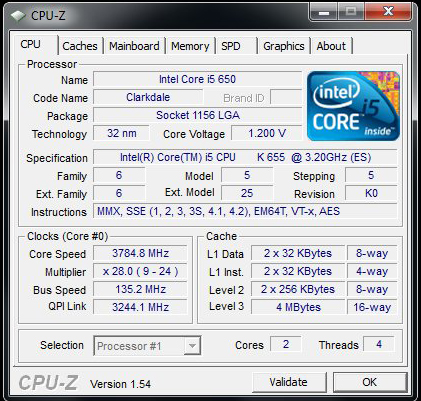
Next up, maximum stable overclocks:
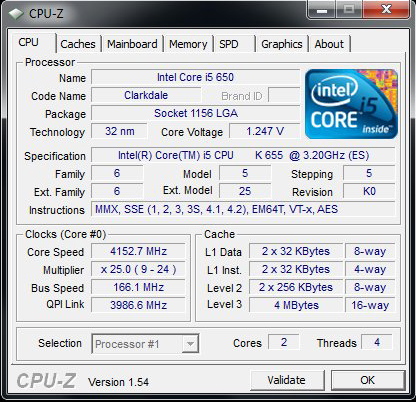
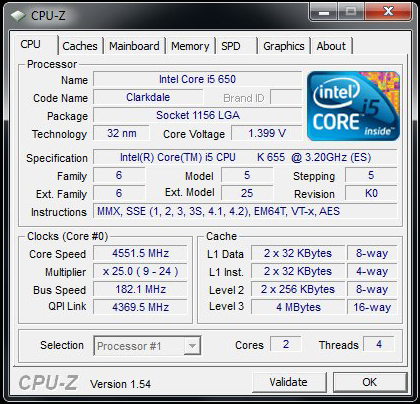
We’re often criticized for being a little brief and thin on overclocking results for our processor launch articles so we’re going to break things down a little further today and take a look at sensible operating points and compare the power curves of different processors.
VID, VCC & Relative Frequency Scaling
First up, let’s take a look at the stock voltages programmed by Intel (VID) for each processor on test today, and the required voltage under full Linpack load at stock frequency and 4.55GHz.
Do note, that actual load voltages will vary from board to board depending upon loadline resistance, Voffset and Vdroop. For the uninitiated, Voffset is difference between the applied voltage and the actual idle state voltage, while Vdroop is the level of voltage sag between idle and full load processor states. These safety margins are necessary to ensure that the real time voltage level (VCC), does not breach the applied VID for extensive periods or by excessive levels (acceptable overshoot margins are stipulated in the Intel white papers). Further explanation of these design principals is provided here.
| Processor | Stock Frequency | Turbo Mode | Stock VID | Stock VCC (Load) | VCC @ ~4.55GHz (Load)* |
| i3-540 | 3.06GHz | N/A | 1.0500V | 1.029V | 1.323V |
| i5-655K | 3.20GHz | 3.46GHz | 1.2125V | 1.190V | 1.378V |
| i5-661 | 3.33GHz | 3.6GHz | 1.1625V | 1.143V | 1.306V |
*Overclocked voltage requirements using water-cooling.
At first glance, the i5-661 stands out for having a relatively low stock VID in relation to its maximum single-threaded Turbo mode speed of 3.6GHz. That’s 160MHz higher than the i5-655K with a small reduction in voltage. Not only that, but it manages to reach 4.55GHz using the lowest VCC of these three test samples.
Here’s a graphical representation of how each processor scales frequency versus voltage, normalized to each part's stock VCC:
Of course, this is but a mere portion of the story, what we’re interested in is the power consumption of each processor at equivalent frequencies and how that has an impact on frequency scaling given various forms of cooling.


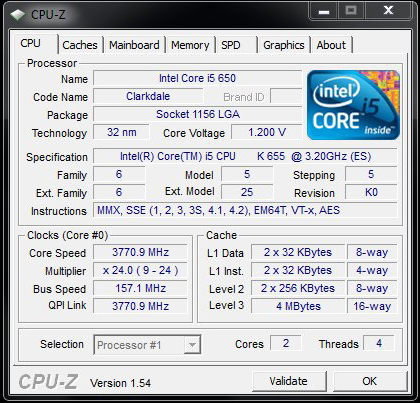
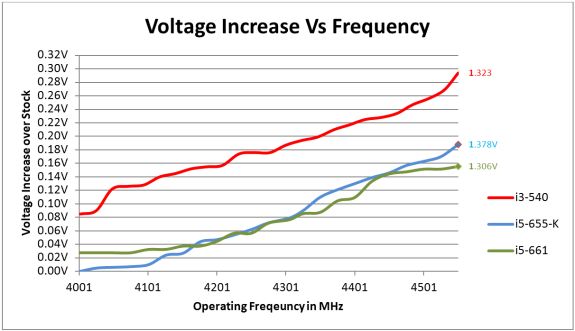








51 Comments
View All Comments
Rajinder Gill - Saturday, May 29, 2010 - link
Hi,I ran out of time to test any further unfortunately. The emphasis was kept on air/water cooling because it's practical to run 24/7.
Regards
Raja
TheBLK - Saturday, May 29, 2010 - link
I'll ask again. Unless the screen shots are wrong you used BLK clock to over-clock rather than multiplier on the chip.Other reviews kept the BLK at the same value and just used the multiplier and seemed to get higher results.
Rajinder Gill - Saturday, May 29, 2010 - link
Yes I did on the 655-K stock VID (added 2 BCLK because the next multiplier up was too far (133 multiples in frequency is a large jump) :http://www.anandtech.com/show/3742/intels-core-i56...
Also describe why BCLK overclocking is not the way to go on the 655K for performance:
http://www.anandtech.com/show/3742/intels-core-i56...
Finally the 855K - this chip is limited to 4GHz even on water cooling. BCLK overclocking is not going to change that. 167 BCLK at DDR3 1670 is nowhere near stressful for the Lynnfield IMC. Multiplier overclocking is NOT going to make any difference to the clock speed limitation.
-Raja
Rajinder Gill - Saturday, May 29, 2010 - link
Just for you :)http://img7.imageshack.us/f/linpackfailj.jpg/
That is all the water loop can handle (the chip is drawing over 190W). I can drop the multiplier down to 30 (but then we are back to 4GHz).
Hope this helps!
Regards
Raja
DJMiggy - Thursday, June 3, 2010 - link
It seems like you guys used the wrong motherboard or got a dud i7. Other reviewers don't seem to be having as tough a time overclocking these higher.Rajinder Gill - Friday, June 4, 2010 - link
The motherboard is EVGA's E659 - works fine with my i7 870 ES taking it to 4.4GHz Linpack stable. It's the CPU that is the limiting factor here. Bear in mind that not all articles you've read will have stability checked stability with Linpack as well.Later
Raja
DJMiggy - Friday, June 4, 2010 - link
That makes sense. Cool thanks! I appreciate the explanation.ReaM - Saturday, June 5, 2010 - link
I must say, what a crappy K-series! I can bring every i7 860 up to 4ghz. I have tested many of them, so there is really no reason to put any hope into these Ks. Just buy a regular one.My personal sample of 860 runs @ 4200 with 1.29V on air Noctua U12 with low temps.
ReaM - Saturday, June 5, 2010 - link
Did you put Load Line Calibration into LVL2?I don't know what's that called on EVGA. Enhanced Power Slope. VDrop Adjustment. Lynnfield, unlike Bloomfield, likes their load line to be adjusted.
Rajinder Gill - Sunday, June 6, 2010 - link
Makes no difference to the stability of this chip.